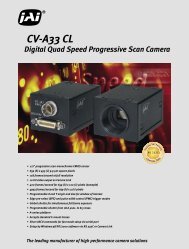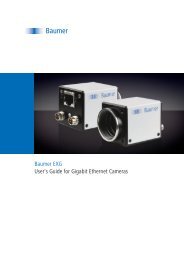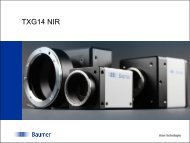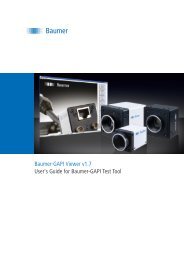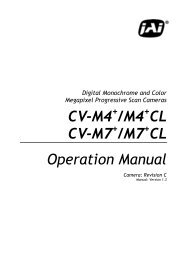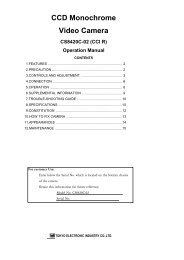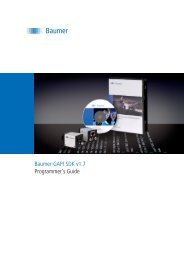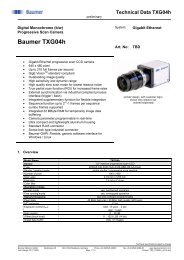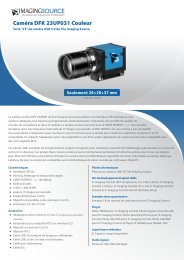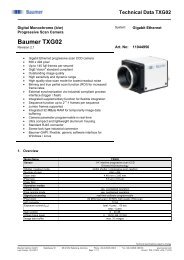ELIIXA+® 8k/4k CL - Site ftp Elvitec
ELIIXA+® 8k/4k CL - Site ftp Elvitec
ELIIXA+® 8k/4k CL - Site ftp Elvitec
Create successful ePaper yourself
Turn your PDF publications into a flip-book with our unique Google optimized e-Paper software.
ELIIXA+® <strong>8k</strong>/<strong>4k</strong> <strong>CL</strong>Cmos Multi-Line CameraFunctionality (Programmable via Control Interface)<strong>8k</strong> Pixels 5µ m : Multi-Lines 1, 2 or 4Sensor modes : Multi-definition,<strong>4k</strong> Pixels 10µm : Binning 1 or 2 LinesMulti-sensitivity2k Pixels 20µm : Binning 4x4, 1 lineAnalog Gain Up to 12 (x4) dBOffset -4096 to +4096 LSBTrigger ModeTimed (Free run) and triggered (Ext Trig, Ext ITC) modesMechanical and Electrical InterfaceSize (w x h x l) 125 x 60 x 135 mmWeight 360 gLens Mount M95 x 1 -Sensor alignment ( see chapter 4 ) ±100 µmSensor flatness 50 µmPower supply Single 12 DC to 24 DC VPower dissipation - CameraLink < 7,5 WGeneral FeaturesOperating temperature 0 to 55 (front face) or 70 (Internal) °CStorage temperature -40 to 70 °CRegulatoryCE, FCC and RoHS compliant1.3 Descriptione2v’s next generation of line scan cameras are setting new, high standards for line rate and image quality.Thanks to e2v’s recently developed multi-line CMOS technology, the camera provides an unmatched 100,000lines/s and combines high response with an extremely low noise level; this delivers high signal to noise ratioeven when short integration times are required or when illumination is limited. The 5µm pixel size is arranged infour active lines, ensuring optimal spatial resolution in both scanning and sensor directions with standard F-mount lenses. Vertical and horizontal binning functions allow the camera to be operated in a 8,192 pixels, 5µm x5µm pixel pitch, 4 active CMOS lines mode or 4,096 pixels, 10µm x 10 µm pixel pitch, 2 active CMOS lines modedepending on the user settings. This versatile feature sets new standard for next generation machine visionsystems1.4 Typical Applications• Raw material surface inspection• General inspection• Flat panel display inspection• PCB inspection• Solar cell inspection• Parcel and postal sorting• High resolution document scanning• Print and paper inspection2 CAMERA PERFORMANCES2.1 Camera CharacterizationUnit Mode 1S (0dB) Mode 2S (0dB) Mode 4S (0dB)Min Typ. Max Min Typ. Max Min Typ. Max5 UM ELIIXA+ <strong>8k</strong>/<strong>4k</strong> <strong>CL</strong> – REVA – 01/13 e2v semiconductors SAS 2013
ELIIXA+® <strong>8k</strong>/<strong>4k</strong> <strong>CL</strong>2.4 Response & QE curves2.4.1 Quantum EfficiencyQuantum Efficiency (%)0.60.50.40.30.20.103603902.4.2 Spectral ResponseLSB12bits/(nJ/cm2))600420450480510540570600630660690720Response in <strong>8k</strong> Pixels 5µm4S 2S 1S7507808108408709009309609901020105010805004003002001000360390420450480510540570600630660690720750780810840870900930960990102010501080nm8 UM ELIIXA+ <strong>8k</strong>/<strong>4k</strong> <strong>CL</strong> – REVA – 01/13 e2v semiconductors SAS 2013
ELIIXA+® <strong>8k</strong>/<strong>4k</strong> <strong>CL</strong>Response in <strong>4k</strong> Pixels 10µm1SB2SBLSB12bits/(nJ/cm2))1200110010009008007006005004003002001000360390420450480510540570600630660690720750780810840870900930960990102010501080nmResponse in 2k Pixels 20µm4SBLSB12bits/(nJ/cm2))2400230022002100200019001800170016001500140013001200110010009008007006005004003002001000360390420450480510540570600630660690720750780810840870900930960990102010501080nm9 UM ELIIXA+ <strong>8k</strong>/<strong>4k</strong> <strong>CL</strong> – REVA – 01/13 e2v semiconductors SAS 2013
ELIIXA+® <strong>8k</strong>/<strong>4k</strong> <strong>CL</strong>3 CAMERA HARDWARE INTERFACE3.1 Mechanical DrawingsZThe Step file is availableon the web :www.e2v.com/camerasXY10 UM ELIIXA+ <strong>8k</strong>/<strong>4k</strong> <strong>CL</strong> – REVA – 01/13 e2v semiconductors SAS 2013
ELIIXA+® <strong>8k</strong>/<strong>4k</strong> <strong>CL</strong>Sensor alignmentZ = -10.6 mm±100µmX = 9.5 mm ±100 µmY = 62.5mm ±100 µmFlatness ±25 µmRotation (X,Y plan) ±0,1°Tilt (versus lens mounting plane) 50µm3.2 Input/output Connectors and LEDUSB ConnectorFor FirmwareupgradePower Connector :12-24V DCMulti-ColoredLED for Statusand diagnosticCameraLinkConnector <strong>CL</strong>2CameraLinkConnector <strong>CL</strong>111 UM ELIIXA+ <strong>8k</strong>/<strong>4k</strong> <strong>CL</strong> – REVA – 01/13 e2v semiconductors SAS 2013
3.2.2 Status LED BehaviourELIIXA+® <strong>8k</strong>/<strong>4k</strong> <strong>CL</strong>After less than 2 seconds of power establishment, the LED first lights up in ORANGE. Then after a Maximumof 40 seconds, the LED must turn in a following colour :Colour and stateGreen and continuousGreen and blinking slowlyRed and continuousMeaningOKWaiting for Ext Trig (Trig1 and/or Trig2)Camera out of order : Internal firmware error3.2.3 CameraLink Output ConfigurationAdjacent ChannelsPixels per ChannelVersions BA0/BA1Base : 2 Channels 8/12bits 2 x 85MHz (80/75/70/65/60MHz) 2 x 4096Medium : 4 Channels 8/12bits 4 x 85MHz (80/75/70/65/60MHz) 4 x 2048Version BA1 (only)Full : 8 Channels 8bits 8 x 85MHz (80/75/70/65/60MHz) 8 x 1024Deca : 10 Channels 8bits 10 x 85MHz (80/75/70/65/60MHz) 10 x 81913 UM ELIIXA+ <strong>8k</strong>/<strong>4k</strong> <strong>CL</strong> – REVA – 01/13 e2v semiconductors SAS 2013
ELIIXA+® <strong>8k</strong>/<strong>4k</strong> <strong>CL</strong>4 STANDARD CONFORMITYThe ELIIXA+ cameras have been tested using the following equipment:• A shielded power supply cable• A Camera Link data transfer cable ref. MVC-1-1-5-2M from CEI (Component Express, Inc.)e2v recommends using the same configuration to ensure the compliance with the following standards.4.1 CE ConformityThe ELIIXA+ cameras comply with the requirements of the EMC (European) directive2004/108/CE (EN50081-2, EN 61000-6-2).4.2 FCC ConformityThe ELIIXA+ cameras further comply with Part 15 of the FCC rules, which states that: Operation issubject to the following two conditions:• This device may not cause harmful interference, and• This device must accept any interference received, including interference that may causeundesired operationThis equipment has been tested and found to comply with the limits for Class A digital device, pursuant topart 15 of the FCC rules. These limits are designed to provide reasonable protection against harmfulinterference when the equipment is operated in a commercial environment. This equipment generates, usesand can radiate radio frequency energy and, if not installed and used in accordance with theinstruction manual, may cause harmful interference to radio communications. Operation of this equipment ina residential area is likely to cause harmful interference in which case the user will be required to correctthe interference at his own expense.Warning: Changes or modifications to this unit not expressly approved by the party responsible forcompliance could void the user's authority to operate this equipment.4.3 RoHs ConformityELIIXA+ cameras comply with the requirements of the RoHS directive 2002/95/EC.14 UM ELIIXA+ <strong>8k</strong>/<strong>4k</strong> <strong>CL</strong> – REVA – 01/13 e2v semiconductors SAS 2013
ELIIXA+® <strong>8k</strong>/<strong>4k</strong> <strong>CL</strong>15 UM ELIIXA+ <strong>8k</strong>/<strong>4k</strong> <strong>CL</strong> – REVA – 01/13 e2v semiconductors SAS 2013
ELIIXA+® <strong>8k</strong>/<strong>4k</strong> <strong>CL</strong>5 GETTING STARTED5.1 Out of the boxThe contains of the Camera box is the following :- One Camera ELIIXA+- Power connector (Hirose HR10A-7P-6S -female)There is no CDROM delivered with the Camera : Both User Manual (this document) and CommCamcontrol software have to be downloaded from the web site : This ensure you to have an up-todateversion.Main Camera page : www.e2v.com/camerasOn the appropriate Camera Page (ELIIXA+ <strong>8k</strong>/<strong>4k</strong>) you’ll find a download linkfirst version of CommCam compliant is indicated in the last ChapterCommCam download requires a login/password : Login : commcam Password : chartreuse5.2 Setting up in the systemWebDirectionFirstPixelwfSensor PlanReadoutDirectionFocal PlanLsFOVwFOV=fLThe Compliant Lenses Mounts are detailed in Appendix D16 UM ELIIXA+ <strong>8k</strong>/<strong>4k</strong> <strong>CL</strong> – REVA – 01/13 e2v semiconductors SAS 2013
6 CAMERA SOFTWARE INTERFACEELIIXA+® <strong>8k</strong>/<strong>4k</strong> <strong>CL</strong>6.1 Control and InterfaceAs all the e2v Cameras, the ELIIXA+ <strong>CL</strong> is delivered with the friendly interface control softwareCOMMCAM.U<strong>CL</strong> (as “Ultimate Camera Link”) which is based on the GenICam standardCOMMCAM recognizes and detects automatically all the U<strong>CL</strong> Cameras connected on any transport layers(Camera Link or COM ports) of your system.Once connected to the Camera you have an easy access to all its features. The visibility of these features canbe associated to three types of users: Beginner, Expert or Guru. Then you can make life easy for simple users.Minimum version of CommCam is 2.1.4 in order to recognize the ELIIXA+ <strong>8k</strong>/<strong>4k</strong> Camera (both versions)17 UM ELIIXA+ <strong>8k</strong>/<strong>4k</strong> <strong>CL</strong> – REVA – 01/13 e2v semiconductors SAS 2013
ELIIXA+® <strong>8k</strong>/<strong>4k</strong> <strong>CL</strong>6.2 Serial Protocol and Command FormatThe Camera Link interface provides two LVDS signal pairs for communication between the camera andthe frame grabber. This is an asynchronous serial communication based on RS-232 protocol.The serial line configuration is: Full duplex/without handshaking 9600 bauds (default), 8-bit data, no parity bit, 1 stop bit. The baud rate can be set up to 1152006.2.1 SyntaxInternal camera configurations are activated by write or readout commands.The command syntax for write operation is:w The command syntax for readout operation is:r 6.2.2 Command ProcessingEach command received by the camera is processed: The setting is implemented (if valid) The camera returns “>”The camera return code has to be received before sending a new command.The camera return code has to be received before sending a new command. Some commands arelonger than the others : Waiting for the return code ensure a good treatment of all the commandsWithout saturating the buffer of the cameraTable 5-1. Camera Returned CodeReturned code meaning>0 (or “>OK”) : All right, the command will be implemented>3 Error Bad CRC (for write command only)>16 Invalid Command ID (Command not recognize or doesn't exist)>33 Invalid Access (the receipt of the last command has failed).>34 Parameter out of range (the parameter of the last command send is out of range).>35 Access Failure (bad communication between two internal devices).6.2.3 GenICam readyThe CameraLink Standard is not yet compliant with GenICam Standard, but as much as possible, eachcommand of the ELIIXA+ will have its correspondence with the Standard Feature Naming Convention of theGenIcam Standard.This correspondence is given in parenthesis for each feature/command as the following example :• Vendor name (DeviceVendorName) : “e2v”18 UM ELIIXA+ <strong>8k</strong>/<strong>4k</strong> <strong>CL</strong> – REVA – 01/13 e2v semiconductors SAS 2013
ELIIXA+® <strong>8k</strong>/<strong>4k</strong> <strong>CL</strong>6.3 Camera Commands6.3.1 InformationThese values allow to indentify the Camera. They can be accessed in CommCam software in the “Info” sectionAll these values are fixed in factory and can’t be changed (shaded) except the Camera User ID which can befixed by the Customer :• Vendor name (DeviceVendorName) : “e2v” Read function : “r vdnm”;Returned by the camera : “e2v”, string of 32 bytes (including “/0”) Can not be written• Model Name (DeviceModelName) : Internal name for GenICam : Read function : “r mdnm”;Returned by the camera : String of 32 bytes (including “/0”) : Can not be written• Device Manufacturer Info (DeviceManufacturerInfo) : Get Camera ID Read function : “r idnb”;Returned by the camera : String of 128 bytes (including “/0”) Can not be written• Device Version (DeviceVersion) : Get Camera Hardware version Read function : “r dhwv”;Returned by the camera : String of 32 bytes (including “/0”) Can not be written• Device Firmware Version (DeviceFirmwareVersion): Get camera synthetic firmware Read function : “r dfwv”;Returned by the camera : String of 16 bytes (including “/0”) Can not be written• Device SFNC Version : 1.5.0These Parameters (Major, Minor, Sub Minor) are only virtual ones in order to give the SFNC compliance ofthe Camera.• Device ID (DeviceID) : Camera Factory identifier ID Read function : “r cust”;Returned by the camera : String of 128 bytes (including “/0”) Write function : “w cust ”• Device User ID (DeviceUserID) : Camera user identifier ID Read function : “r cust”;Returned by the camera : String of 128 bytes (including “/0”) Write function : “w cust ”19 UM ELIIXA+ <strong>8k</strong>/<strong>4k</strong> <strong>CL</strong> – REVA – 01/13 e2v semiconductors SAS 2013
• Electronic board ID (ElectronicBoardID) : Get PcB Board ID Read function : “r boid”;Returned by the camera : String of 32 bytes (including “/0”) Can not be writtenELIIXA+® <strong>8k</strong>/<strong>4k</strong> <strong>CL</strong>• Device Temperature Selector (DeviceTemperatureSelector) : MainBoard Can not be written• Device Temperature (DeviceTemperature) : Get Main Board Temperature Read function : “r temp”;Return by the camera : Temperature in Q10.2 format (8 bits signed + 2 bits below comma). Value isbetween -512 to 511 in °C.• Device Serial Port Selection : Indicates the Serial Port on which the Camera is connected.• Device Serial Port Baud Rate (ComBaudRate): Set the Camera BaudRate Read function : “r baud”;Returned by the camera : Value of the Baud Rate Write function : “w baud” with the index as follows : 1 : 9600 Bauds (default value at power up) 2 : 19200Bauds 6 : 57600Bauds 12 : 115200Bauds• Standby Mode (Standby) : Activation of the Standby mode of the Camera Read function : “r stby”;Returned by the camera : Boolean. 0 : Disable Standby mode (False) 1 : Enable stanby mode (True) Write function : “w stby ”; is 0 or 1. A standby mode, what for ?The Standby mode stops all activity on thesensor level. The power dissipation dropsdown to about 6W. During the standbymode, the grab is stopped°C757065605550Internal TemperatureStandby OffOnce the Standby mode turned off, theCamera recovers in less than 1ms to sendimages again from the sensor.4540353025057102030405060708090Standby OnTime (mn)10011012013014020 UM ELIIXA+ <strong>8k</strong>/<strong>4k</strong> <strong>CL</strong> – REVA – 01/13 e2v semiconductors SAS 2013
• Camera status : Get the Camera status register (32bits Integer) Read function : “r stat”;Returned by the camera : 32bits integer :ELIIXA+® <strong>8k</strong>/<strong>4k</strong> <strong>CL</strong> Bit 0 : (StatusWaitForTrigger) : True ifno trig received from more than 1sec Bit 1 : (StatusTriggerTooFast) :Missing triggers. Trig signal too fast Bit 2 : (StatusSensorConnection) : True is the Sensor pattern is checked as failed. Bit 3, 4, 5, 6, 7 : Reserved Bit 8 : (StatusWarningOverflow) : True is an overflow occurs during FFC or Tap balance processing. Bit 9 : (StatusWarningUnderflow) : True is an underflow occurs during FFC or Tap balance processing Bits 10 : Reserved Bits 11 : Scrolling Direction : 0 = Forward, 1 = Reverse. Updated only by external CC3 (CameraLink) Bits, 12, 13, 14, 15 : Reserved Bit 16 : (StatusErrorHardware) : True if hardware error detected Bits 17 to 31 : Reserved21 UM ELIIXA+ <strong>8k</strong>/<strong>4k</strong> <strong>CL</strong> – REVA – 01/13 e2v semiconductors SAS 2013
ELIIXA+® <strong>8k</strong>/<strong>4k</strong> <strong>CL</strong>6.3.2 Image Format• Sensor Width (SensorWidth) : Get the physical width of the Sensor. This value is available in the CommCam“Image Format Control” section : Read function : “r snsw”;Return by the sensor : Integer 8192. Can not be written;• Sensor Height (SensorHeight) : Get the physical height of the Sensor. This value is available in theCommCam “Image Format Control” section : No Access. Virtual command in xml”; Value always = 1• Width Max (WidthMax) : Get the Maximum Width of the Sensor. This value is available in the CommCam“Image Format Control” section : No Access. The value is mapped on “SensorWidth”• Height Max (HeigthMax) : Get the Maximum height of the Sensor. This value is available in the CommCam“Image Format Control” section : No Access. Virtual command in xml”; Value always = 1• Output mode (OutputMode) : Set the CameraLink Output mode (refer also to Chap 3. : CameraLink OutputConfiguration). This command is available in the CommCam “Image Format Control” section : Read function : “r mode”;Returned by the camera : Output mode from 0 to 3 (see table below). Write function : “w mode” :detailed in the table below :Modes Connector <strong>CL</strong>1 Connector <strong>CL</strong>2 Mode valueBase 2 Channels 8 Bits 2 x 8 bits - tbdBase 2 Channels 12 Bits 2x 12 bits - tbdMedium 4 Channels 8bits 4 x 8 bits 0Medium 4 Channels 12bits 4 x 12 bits 1Full 8 Channels 8bits (BA1 Version Only) 8 x 8 bits 2Full+ 10 Channels 8bits (BA1 Version Only) 10 x 8 bits 322 UM ELIIXA+ <strong>8k</strong>/<strong>4k</strong> <strong>CL</strong> – REVA – 01/13 e2v semiconductors SAS 2013
ELIIXA+® <strong>8k</strong>/<strong>4k</strong> <strong>CL</strong> Structure of the Camera Link Channels for interfacing Base Mode : 2 Channels Separate, outputted from Left to Right.2x4096 pixels each Channel (No Binning)2x2048 pixels in Binning Mode 1SB or 2SB,2x512 pixels in Binning mode 4SB.Ch 1 Ch 2 Medium Mode : 4 Taps Separate, outputted from Left to Right4x2048 pixels each Channel (No Binning)4x1024 pixels in Binning Mode 1SB or 2SB,4x512 pixels in Binning mode 4SB.Ch 1 Ch 2 Ch 3 Ch 4 FULL Mode : 8 Taps Separate, outputted from Left to Right. Available only on BA1 versions.8x1024 pixels each Channel (No Binning)8x512 pixels in Binning Mode 1SB or 2SB,8x256 pixels in Binning mode 4SB.Ch 1 Ch 2 Ch 3 Ch 4 Ch 5 Ch 6 Ch 7 Ch 8FULL+ (Deca) Mode : 10 Taps Separate, outputted from Left to Right. Available only on BA1 versions.10x819 pixels each Channel (No Binning)10x409 pixels in Binning Mode 1SB or 2SB,10x204 pixels in Binning mode 4SB.Ch 1 Ch 2 Ch 3 Ch 4 Ch 5 Ch 6 Ch 7 Ch 8 Ch 9 Ch 1023 UM ELIIXA+ <strong>8k</strong>/<strong>4k</strong> <strong>CL</strong> – REVA – 01/13 e2v semiconductors SAS 2013
ELIIXA+® <strong>8k</strong>/<strong>4k</strong> <strong>CL</strong>• Output Frequency (OutputFrequency) : Set the CameraLink Data Output Frequency. This value is available inthe CommCam “Image Format Control” section : Read function : “r clfq”;Return by the Camera : Frequency from 0 to 5 Write Function : “w clfq ” “0” : 85MHz (default). “1” : 60MHz. “2” : 65MHz. “3” : 70MHz. “4” : 75MHz. “5” : 80MHz.Data Output Frequency ReductionThe Purpose of this feature is to optimize (increase) the Length of the Cable when highestLine Rate is not required. Each decreasing of the Data Frequency will increase the minimum Structure Line Period of the possible, Sensor this depending also on the Binning mode (number of pixels outputted from8192 to 2048FPGAWeb DirectionIn 2S Mode, the summation of thetwo lines is done in the FPGA :B+CIn 4S Mode, the summation of thetwo double lines is done in theFPGA : (AB )+ (BC)This mode works in “Time delayexposure” for the summation ofeach double line in the sensor.Exposuredelays1S2S4SADCMemory NodePixel Line APixel Line BPixel Line CPixel Line DMemory NodeADC24 UM ELIIXA+ <strong>8k</strong>/<strong>4k</strong> <strong>CL</strong> – REVA – 01/13 e2v semiconductors SAS 2013
ELIIXA+® <strong>8k</strong>/<strong>4k</strong> <strong>CL</strong>• Sensor Mode (SensorMode) : Defines the number of Line used on the Sensor. This command is available inthe CommCam “Image Format Control” section : Read function : “r smod”;Returned by the camera : Integer from 0 to 5 Write function : “w smod” : “0” : “1S” mode or Single Line. “1” : “2S” mode or Dual Lines. “2” : “4S” mode or Four Lines. “3” : “1SB” mode : Binning mode (2x2) which outputs on line of <strong>4k</strong> pixels in 10µmx10µm. “4” : “2SB” mode : Binning mode 2 x (2x2) which outputs the summation of 2 lines of <strong>4k</strong> pixels in10µmx10µm. “5” : “4SB” mode : Binning mode (4x4) which outputs 1 line of 2k pixels in 20µmx20µm. Binning modesWeb DirectionThe two binning modes 1SB and2SB give an output of <strong>4k</strong> pixels10x10µm.As for the 2SB mode, thesensor manages the delaybetween the two exposuresnecessary for a “good match”acquisition.The 4SB is a binning 4x4 withan output of 2K pixels20x20µmExposureDelay1SB/2SB1SB2SB2SB4SBADCMemory NodePixel Line APixel Line BPixel Line CPixel Line DMemory NodeADCFull Exposure ControlAs the « 4S » mode is performing an internal Time delay exposure on the lines A & B and C &D, normally, the variation of the Exposure time should not be possible in this sensor mode.Thanks to an e2v licensed solution, two of the Exposure controlled mode (Ext Trig withinternal or External exposure control) are still available in 4S sensor TDE mode.25 UM ELIIXA+ <strong>8k</strong>/<strong>4k</strong> <strong>CL</strong> – REVA – 01/13 e2v semiconductors SAS 2013
ELIIXA+® <strong>8k</strong>/<strong>4k</strong> <strong>CL</strong>• Multi-Line Gain (MultiLineGain) : Enables the MultiLine Gain of x0,5 . This value is available in the CommCam“Image Format Control” section : Read function : “r mlig”;Return by the sensor : “0” if disabled (Gain x1 by default); “1” if Gain x0,5 activated. Write Function : “w mlig ” “0” : Default Gain x1 is active. “1” : Gain x0,5 is enabled (only when the 2S mode of the sensor is enabled) Why Using a Multi-Line Gain of x0,5 ?Web DirectionWhen the Light source is enough to usethe “1S” mode of the Sensor (one singleline), the best is to use 2 lines (“2S”mode) and then to divide the result bytwo by using the Multi-Line Gain set at“x0,5” :In this case, the Full Well capacity ismultiplied by x2 (two output registersare used) but the noise divided by √2therefore the SNR is improved by afactor of √2.Exposuredelays1S2SADCMemory NodePixel Line APixel Line BPixel Line CPixel Line DMemory NodeADC• Reverse Reading (X) (ReverseReading) : Allows to output the line in the Reverse-X direction. This value isavailable in the CommCam “Image Format Control” section : Read function : “r revr”;Return by the Camera : 0 or 1 (enabled/disabled) Write function : “w revr ”; “0” : Disabled. “1” : Enables the reverse reading out (see below for “normal” direction)26 UM ELIIXA+ <strong>8k</strong>/<strong>4k</strong> <strong>CL</strong> – REVA – 01/13 e2v semiconductors SAS 2013
ELIIXA+® <strong>8k</strong>/<strong>4k</strong> <strong>CL</strong>• Scan Direction (ScanDirection) : Set the scan direction for the sensor. This value is available in theCommCam “Image Format Control” section : Read function : “r scdi”;Return by the Camera : 0, 1 or 2 (Forward/reverse/external)Write function : “w scdi ”; “0” : Forward. “1” : Reverse “2” : Externally controlled (by CC3 of theCameraLink Sync signals)Forward/reverse information has to be set correctly as soon as the Mode “2S”, “4S” or 2SB of the sensorare set : In these modes, the sensor/Camera need to know what is the real order of the lines for theexposure delays.The Forward direction is defined as detailed beside :Note : The delay for the Camera to take in account a change inthe ScanDirection value is :- In 2S mode : 1s- In 4S mode : 1,5sWebDirectionThis information can be set dynamically by using the CC3Trig signal of the CameraLink connector (change thedirection “on the fly”).In these case, the Trigger signification is : “0” : Forward. “1” : ReverseFirstPixelReadoutDirectionThis positioning takes also in account that the mode“Reverse X” is “Off” (Normal readout direction)27 UM ELIIXA+ <strong>8k</strong>/<strong>4k</strong> <strong>CL</strong> – REVA – 01/13 e2v semiconductors SAS 2013
ELIIXA+® <strong>8k</strong>/<strong>4k</strong> <strong>CL</strong>• Test Image Selector (TestImageSelector) : Defines if the data comes from the Sensor or the FPGA (testPattern). This command is available in the CommCam “Image Format” section : Read function : “r srce”;Returned by the camera : “0” if Source from the Sensor and “1 to 5” if test pattern active Write function : “w srce” : “0” : To switch to CCD sensor image “1” : Grey Horizontal Ramp (Fixed) : See AppendixA “2” : White Pattern (Uniform white image : 255 in 8Bits or 4095 in 12bits) “3” : Grey Pattern (Uniform middle Grey : 128 in 8bits or 2048 in 12 bits) “4” : Black Pattern (Uniform black : 0 in both 8 and 12 bits) “5” : Grey vertical Ramp (moving)The test pattern is generated in the FPGA : It’s used to point out any interface problem with the FrameGrabber.When any of the Test pattern is enabled, the whole processing chain of the FPGA is disabled.6.3.3 Acquisition ControlThis section deals with all the Exposure, Line period and synchronisation modes• Synchronisation Mode (TriggerPreset) : Timed or Triggered, it defines how the grabbing is synchronized.This command is available in the CommCam “Acquisition Control” section : Read function : “r sync”;Returned by the camera :• “0” : Internal Line Trigger with Exposure time Internally Controlled (Free Run). Not available whenSensor mode is set in “4S” (whatever the firmware version)• “1” : External Trigger with Exposure Time Internally Controlled. Available also when Sensor mode isset in “4S”.• “2” : External Trigger with maximum Exposure time• “3” : One External with Exposure Time Externally Controlled. The same Trigger signal defines the lineperiod and its low level defines the exposure time. Available also when Sensor mode is set in “4S”• “4” : Two External Triggers with Exposure Time Externally Controlled : CC2 defines the start of theexposure (and also the start Line) and CC1 defines the Stop of the exposure. Not available whenSensor mode is set in “4S”• “5” : Internal Line Trigger with maximum Exposure Time Write function : “w sync” The Timing diagrams associated to each Synchronization mode and the Timing values associatedare detailed in the APPENDIX B of this document.28 UM ELIIXA+ <strong>8k</strong>/<strong>4k</strong> <strong>CL</strong> – REVA – 01/13 e2v semiconductors SAS 2013
ELIIXA+® <strong>8k</strong>/<strong>4k</strong> <strong>CL</strong>• Exposure time (ExposureTime): Defines the exposure time when set in the Camera. This command is availablein the CommCam “Acquisition Control” section : Read function : “r tint”;Returned by the camera : Integer from 15 to 65535 (=1,5µs to 6553,5µs by step o 0,1µs) Write function : “w tint” ;This value of exposure time is taken in account only when the synchronisation mode is “free run” (0) or“Ext Trig with Exposure time set” (1). Otherwise it’s ignored.Due to the limitation of the timing pixel inside the sensor, the Exposure time has to be set bytaking in account the limitation detailed in the APPENDIX B of this document.The Minimum exposure time which can be set is 1,5µs• Line Period (LinePeriod) : Defines the Line Period of the Camera in Timed mode. This command is available inthe CommCam “Acquisition Control” section : Read function : “r tper”;Returned by the camera : Integer from 1 to 65536 (=0,1µs to 6553,6µs by step o 100ns) Write function : “w tper” ;The line period is active only in Free Run modes. It’s also disabled if in this mode, the Integration time isset higher than the Line Period.The Tables of the minimum Line Period (Max Line Rate) versus the Data rate and the outputmode chosen are given in Appendix C (Chap. 9.2) of this document.29 UM ELIIXA+ <strong>8k</strong>/<strong>4k</strong> <strong>CL</strong> – REVA – 01/13 e2v semiconductors SAS 2013
ELIIXA+® <strong>8k</strong>/<strong>4k</strong> <strong>CL</strong>6.3.4 Gain and OffsetPreampGainSensorFPGAFFCOffset GainFFCAdjustAmpGainSensorTapGainsLUT orContrast Exp.OffsetGainPixelX+ XXXX+ XOUTAction on whole lineAction per pixelAction per Sensor’s Tap Analog Gain in the ADCThe only analog Gain available inthe ELIIXA+ is located at thesensor level, in the ADCconverter.10 bitsconversionLSB1024x4x2Comparator Rampsat differentGainsThis “Preamp Gain” is in fact avariation of the ramp of thecomparator of the ADC.Then 3 Values are available :x1, x2 and x48 bitsconversion512255x1Clamp (Black Ref)SettingValue issuedfrom the Pixel• Preamp Gain : (Gain with GainSelector= AnalogAll)Set the Pre-amplification Gain. This command is available in the CommCam “Gain & Offset” section. Read function : “r pamp”;Returned by the camera : Integer corresponding to one of the 3 different step values :• 0 : x1 (0dB)• 1 : x2 (6dB)• 2 : x4 (12dB) Write function : “w pamp” ;30 UM ELIIXA+ <strong>8k</strong>/<strong>4k</strong> <strong>CL</strong> – REVA – 01/13 e2v semiconductors SAS 2013
ELIIXA+® <strong>8k</strong>/<strong>4k</strong> <strong>CL</strong>• Gain: (Gain with GainSelector= GainAll)Set the Amplification Gain. This command is available in the CommCam “Gain & Offset” section : Read function : “r gain”;Returned by the camera : Value from 0 to 6193 corresponding to a Gain range of 0dB to +8dB calculatedas following : Gain(dB) = 20.log(1+ Gain/4096). Write function : “w gain” ;• Tap Gain (Gain with GainSelector=TapX) : Read function : “r fga”; is 1 or 2Returns the Gain value for the tap. Ex : “r fga1” returns Gain value Tap1. Write function : “w fga ” : 1 or 2 : from -128 to +127 by step of 1 (0,0021dB each step)• Digital Gain (Gain with GainSelector=DigitalAll) : Set the global Digital Gain. This command is available in theCommCam “Gain & Offset” section : Read function : “r gdig”;Returned by the camera : Integer value from 0 to 255. The corresponding Gain is calculated as20log(1+val/64) in dB Write function : “w gdig” ;• Digital Offset (BlackLevelRaw with BlackLevelSelector=All) : Set the global Digital Offset. This command isavailable in the CommCam “Gain & Offset” section : Read function : “r offs”;Returned by the camera : Value from –4096 to +4095 in LSB Write function : “w offs” ;The Contrast Expansion (both Digital Gain & Offset) will be automatically disabled if the LUT isenabled..• Tap Balance Gains Enable Switch (TapBalanceGainEnable) : Read function : “r fgae”;Returns the Gain value for the tap. Ex : “r fga1” returns Gain value Tap1. Write function : “w fgae ” with : 0 or 1 0 : Disables the Tap Balance Gains 1 : Enables the Tap Balance Gains31 UM ELIIXA+ <strong>8k</strong>/<strong>4k</strong> <strong>CL</strong> – REVA – 01/13 e2v semiconductors SAS 2013
ELIIXA+® <strong>8k</strong>/<strong>4k</strong> <strong>CL</strong>6.3.5 Flat Field Correction How is performed the Flat Field Correction ?What is the Flat Field correction (FFC) ?The Flat Field Correction is a digital correction on each pixel which allows : To correct the Pixel PRNU (Pixel Response Non Uniformity) and DSNU (Dark Signal Non Uniformity) To Correct the shading due to the lens To correct the Light source non uniformityBeforeAfterHow is calculated / Applied the FFC ?The FFC is a digital correction on the pixel level for both Gain and Offset. Each Pixel is corrected with :o An Offset on 8 bits (Signed Int 5.3). They cover a dynamic of ±16LSB in 12bits with a resolution of1/8 LSB 12bits.o A Gain on 14 bits (Unsigned Int 14) with a max gain value of x3o The calculation of the new pixel value is : P’ = ( P + Off).(1 + Gain/8192)The FFC processing can be completed with an automatic adjustment to a global target. This function isdesigned as “FFC Adjust”. This adjustment to a User target is done by an internal hidden gain which is recalculatedeach time the FFC is processed while the FFC adjust function is enabled.The FFC is always processed with the max pixel value of the line as reference. If enabled, the FFC adjustmodule (located at the output of the FFC module) calculates the adjustment gain to reach the targetdefined by the User.When the FFC result is saved in memory, the adjust gain and target are saved in the same time in order toassociate this gain value with the FFC result.32 UM ELIIXA+ <strong>8k</strong>/<strong>4k</strong> <strong>CL</strong> – REVA – 01/13 e2v semiconductors SAS 2013
ELIIXA+® <strong>8k</strong>/<strong>4k</strong> <strong>CL</strong>User Target valueAdjustment gain3020Standard FFC computed onthe max of the linePixelsHow to perform the Flat Field Correction ?FPN/DSNU Calibration Cover the lens Launch the FPN Calibration : Grab and calculation is performed in few secondsPRNU CalibrationThe User must propose a white/gray uniform target to the Camera (not a fixed paper).The Gain/Light conditions must give a non saturated image in any Line.The Camera must be set in the final conditions of Light/ Gain and in the final position in the System.I f required, set a user target for the FFC adjust and enable it. White uniform (moving) target Launch the FFC Enable the FFC You can save the FFC result (both FPN+PRNU in the same time) in one of the 4 x FFC User Banks. The user target and Gain are saved with the associated FFC in the same memory.AdvicesThe ELIIXA+ Cameras have 4 x FFC Banks to save 4 x different FFC calibrations. You can use this featureif your system needs some different conditions of lightning and/or Gain because of the inspection ofdifferent objects : You can perform one FFC per condition of Gain/setting of the Camera ( 4 Max) andrecall one of the four global settings (Camera Configuration + FFC + Line Balance) when required.33 UM ELIIXA+ <strong>8k</strong>/<strong>4k</strong> <strong>CL</strong> – REVA – 01/13 e2v semiconductors SAS 2013
ELIIXA+® <strong>8k</strong>/<strong>4k</strong> <strong>CL</strong>6.3.5.1 Activation and Auto-Adjust• FFC Activation (FFCEnable) : Enable/disable the Flat Field Correction. This command is available in theCommCam “Flat Field Correction” section : Read function : “r ffcp” : Returns the FFC Status (0 if disabled, 1 if enabled) Write function : “w ffcp 1” : Enable the FFC. “w ffcp 0” : Disabled the FFC• FFC Adjust Function : This Feature is available in the CommCam “Flat Field Correction/ AutomaticCalibration” section :ooGains adjust (FFCAdjust): Enable/Disable the function Read function : “r ffad”. Returns the status of the function (0 if disabled) Write function : “w ffad 0” : Disable the FFC Adjust function. “w ffad 1” : Enable the FFC Adjust function.Auto Adjust Target Level (FFCAutoTargetLevel): set the value for the User Target. Read function : “r tfad”. Returns the Target value (from 0 to 4095) Write function : “w tfad ” : Set the Target Value (in 12bits) FFC Adjust : A good usage.When there are several Cameras to set up in a system on a single line, the most difficult is to have auniform lightning whole along the line.If each Camera performs its own Flat field correction, relative to the max of each pixel line, the resultwill be a succession of Camera lines at different levels.=> The FFC Adjust function allows to set the same target value for all the Cameras in the system andthen to get a perfect uniform line whole along the system with a precision of 1 LSB to the Target.The Maximum correction is x2 the highest value of the line.The reasonable value for the User Target is not more than around 20% of the max value of the line.34 UM ELIIXA+ <strong>8k</strong>/<strong>4k</strong> <strong>CL</strong> – REVA – 01/13 e2v semiconductors SAS 2013
ELIIXA+® <strong>8k</strong>/<strong>4k</strong> <strong>CL</strong>6.3.5.2 Automatic Calibration• FPN/DSNU Calibration :ooFPN Calibration Control (FPNCalibrationCtrl) : Launch or abort of the FPN process for the Offsetscalculation. These commands are available in the CommCam “Flat Field Correction / AutomaticCalibration ” section : Read function : “r calo” : Returns the FPN Calculation Process Status (0 if finished, 1 ifprocessing) Write function : “w calo 1” : Launch the FPN Calibration Process. “w calo 0” : Abort the FPN Calibration Process.FPN Coefficient Reset (FPNReset) : Reset the FPN (Offsets) coefficient in Memory. This commandis available in the CommCam “Flat Field Correction / Manual Calibration ” section : Write function : “w rsto 0” : Reset (set to 0) the FPN coefficients in memory. This doesn’t affectthe FFC User Memory Bank but only the active coefficients in Memory.• PRNU Calibration :o PRNU Calibration Control (FFCCalibrationCtrl) : Launch or abort of the PRNU process for the Gainscalculation. This command is available in the CommCam “Flat Field Correction / Automatic Calibration ”section : Read function : “r calg” : Returns the PRNU Calculation Process Status (0 if finished, 1 ifprocessing) Write function : “w calg 1” : Launch the PRNU Calibration Process. “w calg 0” : Abort the PRNU Calibration Process.oPRNU coefficient Reset (PRNUReset) : Reset the PRNU (Gains) coefficient in Memory. Thiscommand is available in the CommCam “Flat Field Correction / Manual Calibration ” section : Write function : “w rstg 0” : Reset (set to “x1”) the PRNU coefficients in memory. This doesn’taffect the FFC User Memory Bank but only the active coefficients in Memory.Some Warnings can be issued from the PRNU/FPN Calibration Process as “pixel Overflow” of “PixelUnderflow” because some pixels have been detected as too high or too low in the source image to becorrected efficiently.The Calculation result will be proposed anyway as it’s just a warning message.The Status Register is the changed and displayed in CommCam “Status” section :Register status is detailed chap §6.3.3.35 UM ELIIXA+ <strong>8k</strong>/<strong>4k</strong> <strong>CL</strong> – REVA – 01/13 e2v semiconductors SAS 2013
6.3.5.3 Manual Flat Field CorrectionELIIXA+® <strong>8k</strong>/<strong>4k</strong> <strong>CL</strong>The FFC Coefficients can also be processed outside of the Camera or changed manually by accessing directlytheir values in the Camera : This is the “Manual” FFC.In CommCam, the User can access to a specific interface by clicking on “click for extended control” in both“Manual FFC calibration” and “Manual FPN calibration sections” :This will allow the user to upload/download out/in the Camera the FFC coefficients in/from a binary or textfile that can be processed externally.It is recommended to setup the baud rate at the maximum value possible (115000 for example)otherwise the transfer can take a long time.• FPN coefficients modification : Direct access to the FPN coefficients for reading or writing.The FPN coefficients are read packets of x128 coefficients : Read function : “r ffco ” : Read 128 consecutive FPN user coefficients starting from address. Returned value is in hexadecimal, without space between values (one unsigned short percoefficient). Write function :” w ffco : Write 128 consecutive FPN user coefficients starting fromthe address. is the concatenation of individual FPN values, without space between thevalues (one unsigned short per coefficient).• PRNU coefficients modification : Direct access to the PRNU coefficients for reading or writing.The PRNU coefficients are read packets of x128 coefficients : Read function : “r ffcg ” : Read 128 consecutive PRNU user coefficients starting from address. Returned value is in hexadecimal, without space between values (one unsigned short percoefficient). Write function :” w ffcg : Write 128 consecutive PRNU user coefficients starting fromthe address. is the concatenation of individual PRNU values, without space between thevalues (one unsigned short per coefficient).36 UM ELIIXA+ <strong>8k</strong>/<strong>4k</strong> <strong>CL</strong> – REVA – 01/13 e2v semiconductors SAS 2013
6.3.5.4 FFC User Bank ManagementELIIXA+® <strong>8k</strong>/<strong>4k</strong> <strong>CL</strong>The new-processed FFC values can be saved or restored in/from 4 x User banks.Both Gains and Offsets in the same time but also the FFC Adjust User target and associated gain.These functions are available in the Flat Field correction/Save & Restore FFC section :Restore FFC from Bank (RestoreFFCFromBank) : Restore the FFC from a Bank in the current FFC. Read function : “r rffc” : Get the current FFC Bank usedReturned by the camera : 0 for Factory bank or 1 to 4 for User banks Write function : “w rffc ” : Bank 1 to 4 for User banksNote : Factory means neutral FFC (no correction).Save FFC in User Bank (SaveFFCToBank) : Save current FFC in User Bank Can not de read Write function : “w sffc ” : User bank if from 1 to 4. FFC User Bank UsageUserSaveUser1User2User3User4LoadRam MemoryAt the power up :- Last User Bank used isloaded in RAMReset a User bank :- Reset the RAM(FPN/PRNU individually)- Save in the bank toresetReset FPNReset PRNU37 UM ELIIXA+ <strong>8k</strong>/<strong>4k</strong> <strong>CL</strong> – REVA – 01/13 e2v semiconductors SAS 2013
6.3.6 Look Up TableELIIXA+® <strong>8k</strong>/<strong>4k</strong> <strong>CL</strong>The User can define an upload a LUT in the Camera that can be used at the end of the processing.The LUT is defined as a correspondence between each of the 4096 gray levels (in 12 bits) with anotheroutputted value. For example, a “negative” or “reverse” LUT is the following equivalence :Real value Output value0 40951 40942 4093…Then the size of each value is 12bits but the exchanges with the Application/PC are done on 16 bits :For 4096 gray levels (from 0 to 4095) the total file size for a LUT is 8Ko.If this LUT is enables, the “Contrast Expansion” feature (digital Gain and Offset) will be disabledLUT Enable (LUTEnable) : Enable the LUT and sizable the Digital Gain / OffsetThis function is available in the LUT section :. Read function : “r lute” : Get the LUT statusReturned by the camera : 0 is LUT disabled, 1 if enabled Write function : “w lute ” : is 0 for disable, 1 for enable• Upload / Download the LUT coefficients : Direct access to the LUT coefficients for reading or writing.In CommCam, the User can access to a specific interface by clicking on “click for extended control” in theLUT section :38 UM ELIIXA+ <strong>8k</strong>/<strong>4k</strong> <strong>CL</strong> – REVA – 01/13 e2v semiconductors SAS 2013
ELIIXA+® <strong>8k</strong>/<strong>4k</strong> <strong>CL</strong> Read function : “r lutc ” : Read 128 LUT coefficients starting from address from 0 to4095-128. Returned value is the concatenation in hexadecimal of individual LUT values, without spacebetween values. (one unsigned short per coefficient) Write function :” w lutc : Write 128 LUT coefficients starting from address form 0 to 4095-128. is the concatenation in hexadecimal of individual LUT values, without spacebetween values. (one unsigned short per coefficient)• Save & Restore LUT in User Banks : The LUT loaded in RAM memory can be saved or restored in/from 4User banks.These functions are available in the LUT/Save & Restore LUT Settings section :ooRestore LUT from Bank (RestoreLUTFromBank) : Restore the LUT from a User Bank in the currentRAM Memory. Read function : “r rlut” : Get the current LUT Bank usedReturned by the camera : 1 to 4 for User banks Write function : “w rlut ” : Bank 1 to 4 for User banksSave LUT in User Bank (SaveLUTToBank) : Save current LUT in User Bank Can not de read Write function : “w slut ” : User bank if from 1 to 4.The bank number is given in (LUTSetSelector) LUT User Bank UsageUpload/load from/to a Txt fileUserUser1User2User3User4SaveLoadRam MemoryAt the power up :- Last User Bank used is loaded in RAM39 UM ELIIXA+ <strong>8k</strong>/<strong>4k</strong> <strong>CL</strong> – REVA – 01/13 e2v semiconductors SAS 2013
ELIIXA+® <strong>8k</strong>/<strong>4k</strong> <strong>CL</strong>6.3.7 Statistics and Line ProfileThis function allows the User to get some statistics on a pre-defined ROI. On request, the Camera acquiresand then calculates some key values as the min, the max, the average or the standard deviation in this Regionof Interest.The grab and calculation command and also the collection of the results is not performed in real time as it isdone through the serial connection.This function and the results are available in CommCam in the “Line Profile Average” Section :Line Profile average measurement (LineAverageProfile) : Control the grab and computation of the statistics. Read function : “r pixs” : Get the status of the calculationReturned by the camera : 0 : finished, 1: running Write function : “w pixs 1” : Start the accumulation and then the computing “w pixs 0” : Abort the computing.The Calculated values are detailed as following :o Pixel average Value (PixelROIMean) : Average gray level value calculated on whole Region of interest Read function : “r pavr” : Get the average valueReturned by the camera : Unsigned format value : U12.4o Pixel Standard deviation (PixelROIStandardDeviation) : standard deviation of all the pixel gray levelvalues of Region of interest Read function : “r pstd” : Get the standard deviationReturned by the camera : Unsigned format value : U12.4o Pixel Min value (PixelROIMin) : Minimum gray level pixel value on the whole region of interest. Read function : “r pmin” : Get the Minimum valueReturned by the camera : Unsigned format value : U12.4o Pixel Max Value (PixelROIMax) : Maximum gray level pixel value on the whole region of interest Read function : “r pmax” : Get the maximum valueReturned by the camera : Unsigned format value : U12.4Pixel access Line number (PixelAccessLineNumer) : Set the number of lines to accumulate. Read function : “r pixl” : Get the number of lineReturned by the camera : 1, 256, 512 or 1024 Write function : “w pixl ” : Set the number of lines. is 1, 256, 512 or 1024.Pixel ROI Start (PixelRoiStart) : Set the Region of Interest start position. Read function : “r prod” : Get the starting pixelReturned by the camera : value between 0 and 16383 Write function : “w prod ” : Set the starting pixel. is between 0 and 16383. Pixel ROI Width (PixelRoiWidth) : Set the Width of the Region of Interest. Read function : “r prow” : Get the width in pixelReturned by the camera : value between 1 and 16384 Write function : “w prow ” : Set the ROI width in pixels. is between 1 and 1638440 UM ELIIXA+ <strong>8k</strong>/<strong>4k</strong> <strong>CL</strong> – REVA – 01/13 e2v semiconductors SAS 2013
ELIIXA+® <strong>8k</strong>/<strong>4k</strong> <strong>CL</strong>After performing a line profile measurement, all the values computed which are described below arenot refreshed automatically in CommCam : You have to right-click on each value and ask for anindividual refresh.6.3.8 Privilege LevelThere are 3 privilege levels for the camera : Factory (0) : Reserved for the Factory Integrator (1) : Reserved for system integrators User (2) : For all Users.The Cameras are delivered in Integrator mode. They can be locked in User mode and a specific password isrequired to switch back the Camera in Integrator mode. This password can be generated with a specific toolavailable from the hotline (hotline-cam@e2v.com)This function is available in the Privilege section :Privilege level Management (PrivilegeLevel) : Get the current Camera privilege level.. Read function : “r lock” : Get the current privilegeReturned by the camera : 0 to 2 Write function : “w lock ” : is as follow 2 : Lock the Camera in Integrator or “privilege User” : Unlock the Camera back in Integrator mode41 UM ELIIXA+ <strong>8k</strong>/<strong>4k</strong> <strong>CL</strong> – REVA – 01/13 e2v semiconductors SAS 2013
ELIIXA+® <strong>8k</strong>/<strong>4k</strong> <strong>CL</strong>6.3.9 Save & Restore SettingsThe settings (or Main configuration) of the Camera can be saved in 4 different User banks and oneIntegrator bank. This setting includes also the FFC and LUT enableThis function is available in the Save & Restore Settings section :• Load settings from Bank : Allows to restore the Camera settings. Read function : “r rcfg” : Get the current Tap Bank in use Write function : “w rcfg ” : Load settings from bank (0: Factory , 1 to 4 for Users, 5 forIntegrator)Save settings to Bank : Allows to save the Camera settings in User or Integrator Bank Write function : “w scfg ” : Save the current settings in the User bank (1 to 4 for User, 5for Integrator)The integrator bank (User Set5) can be written only if the Camera is set in integrator mode(Privilege level = 1). This integrator bank can be used as a « Factory default » by a systemintegrator. Configuration Bank UsageUserUser1User2SaveLoadRam MemoryLoadFactoryUser3User4IntegratorSaveAt the power up : Last User Bank used is loaded in RAM“Integrator” Bank (5) can be locked by switching the Camera in “User” mode (cf : Privilege feature).Then it can’t be saved any more without switching back the Camera in “Integrator” Mode.42 UM ELIIXA+ <strong>8k</strong>/<strong>4k</strong> <strong>CL</strong> – REVA – 01/13 e2v semiconductors SAS 2013
ELIIXA+® <strong>8k</strong>/<strong>4k</strong> <strong>CL</strong>7 APPENDIX A: Test Patterns7.1 Test Pattern 1: Vertical waveThe Test pattern 1 is a vertical moving wave : each new line will increment of 1 gray level in regards with theprevious one. In 12 bits the level reaches 4095 before switching down to 0 In 8 bits the level reaches 255 before switching down to 07.2 Test Pattern 2: Fixed Horizontal Ramps7.2.1 In 8 bits (Full) format – No Binning (8192 pixels)191817An increment of 1 LSB is made every 8 pixelsWhen it reaches 255, turns back to 0 and starts again161514250 260 270 280 29043 UM ELIIXA+ <strong>8k</strong>/<strong>4k</strong> <strong>CL</strong> – REVA – 01/13 e2v semiconductors SAS 2013
ELIIXA+® <strong>8k</strong>/<strong>4k</strong> <strong>CL</strong>7.2.2 In 12 bits (Medium) format – No Binning (8192 pixels)300295290285An increment of 1 LSB is made for each pixel. When itreaches 4095, turns back to 0 and starts again280275270265260255250250 260 270 280 29044 UM ELIIXA+ <strong>8k</strong>/<strong>4k</strong> <strong>CL</strong> – REVA – 01/13 e2v semiconductors SAS 2013
ELIIXA+® <strong>8k</strong>/<strong>4k</strong> <strong>CL</strong>7.2.3 In 8/12 bits Full/Medium format with Binning (4096 Pixels)7065605550454035300 100 200 300 400 500Pixel 0 : 32Pixel 1 : 32…Pixel 15 : 32Pixel 16 : 33Pixel 17 : 33…Pixel 31 : 33Pixel 32 : 34…Pixel 511 : 63Pixel 512 : 96Pixel 513 : 96…Pixel 2047 : 255Pixel 2048 : 32…45 UM ELIIXA+ <strong>8k</strong>/<strong>4k</strong> <strong>CL</strong> – REVA – 01/13 e2v semiconductors SAS 2013
ELIIXA+® <strong>8k</strong>/<strong>4k</strong> <strong>CL</strong>8 APPENDIX B: Timing Diagrams8.1 Synchronization Modes with Variable Exposure TimeT dT hSynchroModeLine TriggerCC1 or InternalT int (Exposure Time)Exposure TimeProgrammedT perExposure TimeProgrammedSync = 0Sync = 1ITC TriggerCC1T intProgT htSync = 3Line TriggersCC1Sync = 4CC2Exposure TimeInternalTint realT xIn theCamera /sensorT pixDigital ConversionNo Exposure start before this pointT pix : Timing Pixel. During this uncompressible period, the pixel and its black reference are read out to theDigital converter. During the first half of this timing pixel (read out of the black reference), we can considerthat the exposure is still active.Digital Conversion : During the conversion, the analog Gain is applied by the gradient of the counting ramp(see next chapter : Gain & Offset). The conversion time depends on the pixel format :- 8 or 10 bits : 6µs- 12 bits : 24µsThis conversion is done in masked time, eventually during the next exposure period.T d : Delay between the Start exposure required and the real start of the exposure.46 UM ELIIXA+ <strong>8k</strong>/<strong>4k</strong> <strong>CL</strong> – REVA – 01/13 e2v semiconductors SAS 2013
ELIIXA+® <strong>8k</strong>/<strong>4k</strong> <strong>CL</strong>If T per is the Line Period (internal or external coming from the Trigger line), in order to respectthis line Period, the Exposure Time as to be set by respecting : T int + T pix = T pixFor a Line Period of LinePer, the maximum exposure time possible without reduction of line rateis : Tint max = T per -T pix (T pix is defined above) but the effective Exposure Time will be aboutTint real = T int + T x . - T d .8.2 Synchronisation Modes with Maximum Exposure TimeLine TriggerCC1 or InternalT dT per = T intT hSynchroModeSync = 2Sync = 5Exposure TimeInternalT xTint realT xIn theCamera /sensorT pixT pixDigital ConversionDigital ConversionIn these modes, the rising edge of the Trigger (internal or External) starts the readout process (T pix ) of theprevious integration. The Real exposure time (Tint real ) is finally equal to the Line Period (T per ) even if it’s delayedfrom (T x + T d ) from the rising edge of the incoming Line Trigger.47 UM ELIIXA+ <strong>8k</strong>/<strong>4k</strong> <strong>CL</strong> – REVA – 01/13 e2v semiconductors SAS 2013
ELIIXA+® <strong>8k</strong>/<strong>4k</strong> <strong>CL</strong>8.3 Timing ValuesLabel Min UnitT pix5 µsT x3,1 µsT h0,120 µsT ht T pixµsecT d1.1 µs20µs17µsTper minTint real2,5µs1,5µs15µsTint prog48 UM ELIIXA+ <strong>8k</strong>/<strong>4k</strong> <strong>CL</strong> – REVA – 01/13 e2v semiconductors SAS 2013
ELIIXA+® <strong>8k</strong>/<strong>4k</strong> <strong>CL</strong>9 APPENDIX C: CameraLink Data Cables9.1 Choosing the CableYou may check the compliance of your CameraLink cables with the transportation of the 85MHz data rate.The main parameter to be checked in the cable specification is the skew (in picoseconds)This parameter is given for a dedicated maximum value per meter of cable (as max : 50ps/m)The CameraLink Standards defines the maximum total skew possible for each data rate :420400380360340320300280260240220200180160140120100806040200Skew (ps)0 5 10 15 20 25 30 35 40 45 50 55 60 65 70 75 80 85 90Data rate (MHz)Here is a following example of cable and the cable length limitation in accordance with the standard :DataRate Skew Cable Length40Mhz 390ps 7,8m66MHz 290ps 5,8m70MHz 270ps 5,4m80MHz 218ps 4,36m85MHz 190ps 3,8m49 UM ELIIXA+ <strong>8k</strong>/<strong>4k</strong> <strong>CL</strong> – REVA – 01/13 e2v semiconductors SAS 2013
ELIIXA+® <strong>8k</strong>/<strong>4k</strong> <strong>CL</strong>9.2 Choosing the Data RateMinimum Line Rates tables versus Data rate and modeData Frequency : 85MHzSensor ModeBase 8/12bits Medium 8/12bits Full 8 tap 8bits Full + 10 tap 8bitsLine Rate Max(kHz)Tper Min(µs)Line Rate Max(kHz)Tper Min (µs)Line RateMax (kHz)Tper Min(µs)Line RateMax (kHz)1S, 2S, 4S (8K 5µm) 20/20 50/50 40/40 25.0/25.0 80 12.5 100 101SB, 2SB (4K 10µm) 40/40 25.0/25.0 80/40 12.5/25.0 100 10.0 100 104SB (2K 20µm) 80/40 12.5/25.0 100/40 10.0/25.0 100 10.0 100 10Tper Min(µs)Data Frequency : 80MHzSensor ModeBase 8/12bits Medium 8/12bits Full 8 tap 8bits Full + 10 tap 8bitsLine Rate Max(kHz)Tper Min(µs)Line Rate Max(kHz)Tper Min (µs)Line RateMax (kHz)Tper Min(µs)Line RateMax (kHz)1S, 2S, 4S (8K 5µm) 18.8/18.8 53.2/53.2 37.6/37.6 26.6/26.6 75.1 13,3 93.5 10.71SB, 2SB (4K 10µm) 37.6/37.6 26.6/26.6 75.1/40 13,3/25.0 100 10.0 100 104SB (2K 20µm) 75.1/40 13.3/25.0 100/40 10.0/25.0 100 10.0 100 10Tper Min(µs)Data Frequency : 75MHzSensor ModeBase 8/12bits Medium 8/12bits Full 8 tap 8bits Full + 10 tap 8bitsLine Rate Max(kHz)Tper Min(µs)Line Rate Max(kHz)Tper Min (µs)Line RateMax (kHz)Tper Min(µs)Line RateMax (kHz)1S, 2S, 4S (8K 5µm) 17.8/17.8 56.4/56.4 35.5/35.5 28.2/28.2 70.4 14.2 87.7 11.41SB, 2SB (4K 10µm) 35.5/35.5 28.2/28.2 70.4/40 14.2/25 100 10.0 100 104SB (2K 20µm) 70.4/40 14.2/25.0 100/40 10.0/25.0 100 10.0 100 10Tper Min(µs)Data Frequency : 70MHzSensor ModeBase 8/12bits Medium 8/12bits Full 8 tap 8bits Full + 10 tap 8bitsLine Rate Max(kHz)Tper Min(µs)Line Rate Max(kHz)Tper Min (µs)Line RateMax (kHz)Tper Min(µs)Line RateMax (kHz)1S, 2S, 4S (8K 5µm) 16.6/16.6 60.4/60.4 33.1/33.1 30.2/30.2 66.2 15.1 82.6 12.11SB, 2SB (4K 10µm) 33.1/33.1 30.2/30.2 66.2/40 15.1/25 100 10.0 100 104SB (2K 20µm) 66.2/40 15.1/25.0 100/40 10.0/25.0 100 10.0 100 10Tper Min(µs)Data Frequency : 65MHzSensor ModeBase 8/12bits Medium 8/12bits Full 8 tap 8bits Full + 10 tap 8bitsLine Rate Max(kHz)Tper Min(µs)Line Rate Max(kHz)Tper Min (µs)Line RateMax (kHz)Tper Min(µs)Line RateMax (kHz)1S, 2S, 4S (8K 5µm) 15.5/15.5 64.8/64.8 30.9/30.9 32.4/32.4 61.7 16.2 76.9 131SB, 2SB (4K 10µm) 30.9/30.9 32.4/32.4 61.7/40 16.2/25.0 100 10.0 100 104SB (2K 20µm) 61.7/40 16.2/25.0 100/40 10.0/25.0 100 10.0 100 10Tper Min(µs)Data Frequency : 60MHzSensor ModeBase 8/12bits Medium 8/12bits Full 8 tap 8bits Full + 10 tap 8bitsLine Rate Max(kHz)Tper Min(µs)Line Rate Max(kHz)Tper Min (µs)Line RateMax (kHz)Tper Min(µs)Line RateMax (kHz)1S, 2S, 4S (8K 5µm) 14.5/14.5 69.2/69.2 28.9/28.9 34.6/34.6 57.8 17.3 71.9 13.91SB, 2SB (4K 10µm) 28.9/28.9 34.6/34.6 57.8/40 17.3/25 100 10.0 100 104SB (2K 20µm) 57.8/40 17.3/25 100/40 10.0/25.0 100 10.0 100 10Tper Min(µs)50 UM ELIIXA+ <strong>8k</strong>/<strong>4k</strong> <strong>CL</strong> – REVA – 01/13 e2v semiconductors SAS 2013
ELIIXA+® <strong>8k</strong>/<strong>4k</strong> <strong>CL</strong>10 APPENDIX D: Lens Mounts10.1 F-MountF Mount : Kit10 (Part number EV71KFPAVIVA-ABA)51 UM ELIIXA+ <strong>8k</strong>/<strong>4k</strong> <strong>CL</strong> – REVA – 01/13 e2v semiconductors SAS 2013
ELIIXA+® <strong>8k</strong>/<strong>4k</strong> <strong>CL</strong>10.2 T2 & M42x1 MountsM42x0,75 (T2 Mount) : Kit30 (Part number AT71KFPAVIVA-AKA)M42x1 Mount : Kit40 (Part number AT71KFPAVIVA-ADA)52 UM ELIIXA+ <strong>8k</strong>/<strong>4k</strong> <strong>CL</strong> – REVA – 01/13 e2v semiconductors SAS 2013
11 APPENDIX E: TROUBLESHOOTINGELIIXA+® <strong>8k</strong>/<strong>4k</strong> <strong>CL</strong>11.1 CameraCameraPower up43sFixedOrangeNo LEDLED ColorRedIf CommCamconnection possible :then the LED is HS,else :Check power supplyAnd its characteristicsContact HotlineBlinkingGreenCamera waitsfor Trigger orTrigger too fastFixedGreenCamera readyHardware failureor Firmware loadingdefect.Contact Hotline forRMA11.2 CommCam ConnectionRefer to CommCam software Help for the connection issues.53 UM ELIIXA+ <strong>8k</strong>/<strong>4k</strong> <strong>CL</strong> – REVA – 01/13 e2v semiconductors SAS 2013
ELIIXA+® <strong>8k</strong>/<strong>4k</strong> <strong>CL</strong>12 APPENDIX F: Revision HistoryManualRevisionRev AComments / Details Firmware version 1 st CommCamcompliantVersionFirst release (Base Mode and Quarter Balance not available)Version BA0Version BA11.0.0B1.0.1A2.1.454 UM ELIIXA+ <strong>8k</strong>/<strong>4k</strong> <strong>CL</strong> – REVA – 01/13 e2v semiconductors SAS 2013
ELIIXA+® <strong>8k</strong>/<strong>4k</strong> <strong>CL</strong>Whilst e2v has taken care to ensure the accuracy of the information contained herein it accepts no responsibility for the consequences of any use thereofand also reserves the right to change the specification of goods without notice. e2v accepts no liability beyond that set out in its standard conditions of salein respect of infringement of third party patents arising from the use of tubes or other devices in accordance with information contained herein.55 UM ELIIXA+ <strong>8k</strong>/<strong>4k</strong> <strong>CL</strong> – REVA – 01/13 e2v semiconductors SAS 2013



